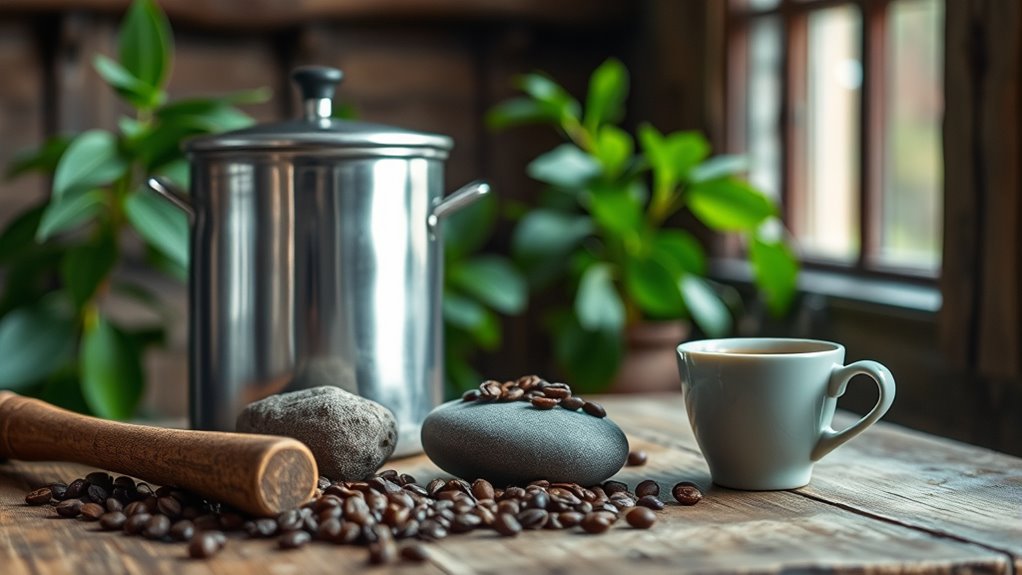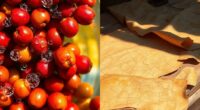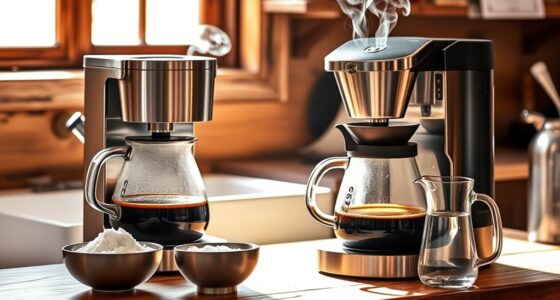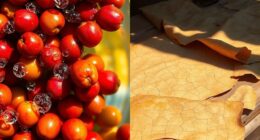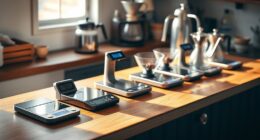If you don’t have a grinder, there are easy ways to grind coffee beans. You can use a mortar and pestle for a fine grind or a food processor for a more consistent texture. A blender works well too—just pulse in short bursts. Alternatively, you can crush beans in a zip-top bag using a heavy object. Each method suits different brewing styles, and knowing which to use can enhance your coffee experience. Explore more techniques that can help you!
Key Takeaways
- Use a mortar and pestle for precise control over grind size, achieving a fine consistency ideal for espresso or Turkish coffee.
- A food processor can efficiently grind larger quantities of coffee beans to a consistent medium grind suitable for various brewing methods.
- For a coarse grind, place beans in a zip-top bag and crush them with a heavy object or rolling pin.
- Short bursts in a blender can yield a consistent grind; be cautious of overheating to avoid a bitter taste.
- Consider borrowing a grinder or utilizing grocery store grinding services for a convenient and cost-effective solution.
Understanding the Importance of Grinding Coffee Beans

Grinding coffee beans is an essential step in brewing a great cup of coffee. When you grind whole bean coffee right before brewing, you’re ensuring the freshest flavor and aroma possible. Fresh ground coffee maximizes taste, preserving vital oils until extraction.
Remember, the grind size is important; a coarse grind works best for a French press, while espresso requires a fine grind. Pre-ground coffee often lacks depth and can be too finely ground for certain methods, diminishing your coffee experience.
If you can grind coffee beans without a grinder, focus on achieving the right grind size for your brewing method. Investing in a quality grinder can greatly elevate your daily coffee ritual, making every sip worth it.
Effective Methods for Grinding Coffee Without a Grinder

If you find yourself without a grinder, don’t worry—you can still achieve a flavorful cup of coffee using alternative methods. Here are some effective techniques:
| Method | Description | Grind Type |
|---|---|---|
| Mortar and Pestle | Crush small batches for precise control. | Fine grind |
| Food Processor | Grind larger quantities evenly and efficiently. | Medium grind |
| Zip-top bag | Use a heavy object to crush beans for a coarse grind. | Coarse grind |
You can also use a rolling pin to crush beans in a bag, providing an uneven but usable grind for drip coffee. Each method has its strengths, so choose one that suits your brewing style!
Using a Blender for Coffee Grinding
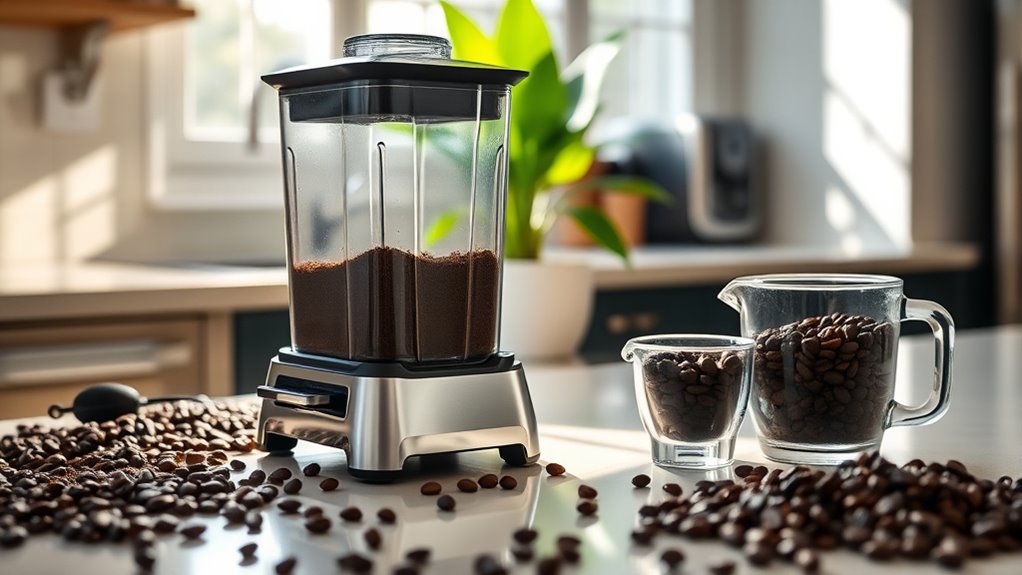
Using a blender can be an effective way to grind coffee beans when you don’t have a traditional grinder on hand.
To achieve a consistent grind, use short bursts of about three seconds and employ the pulse function. Tilt the blender slightly to help larger chunks of beans move toward the blades for a more even texture.
It’s best to process only small batches, around 1/4 cup at a time, to prevent overheating and guarantee uniformity. Be mindful of the heat generated during grinding, as this can burn the beans and create a bitter flavor.
After grinding, check for any unground pieces and repeat the process until you reach your desired consistency.
Grinding Coffee With a Food Processor
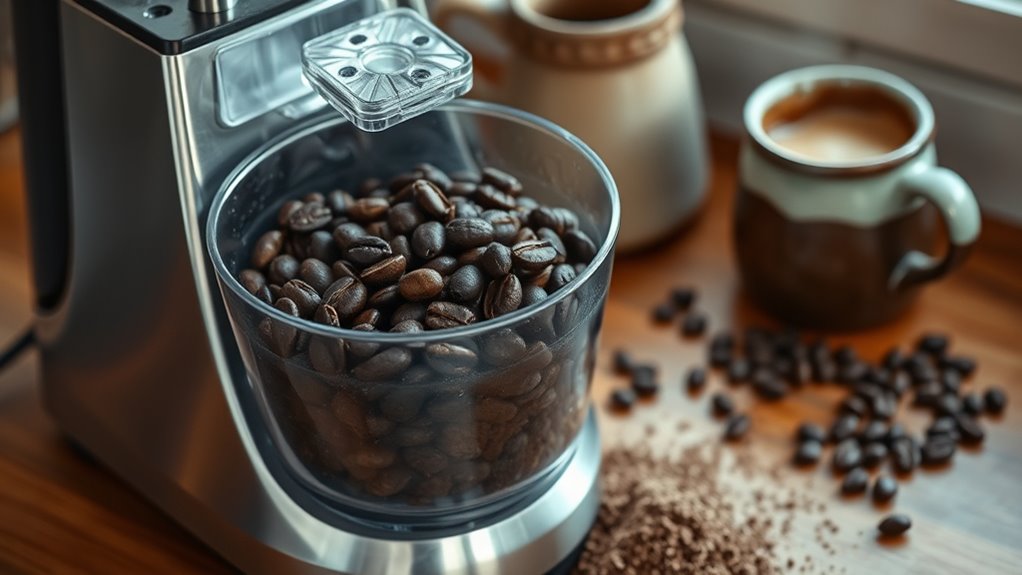
If you’ve got a food processor, you’re in luck!
It can effectively grind coffee beans, often giving you a more consistent result compared to a blender.
With the right techniques, you can achieve your ideal grind size while making enough coffee for everyone.
Benefits of Food Processor
A food processor can be a game changer when it comes to grinding coffee beans. Unlike a blender, its wider bowl allows for better movement, resulting in a more even grind.
You can easily grind larger quantities, typically between 1/3 to 1/2 cup at once, perfect for brewing multiple servings. By utilizing short pulses of about 15 seconds, you’ll achieve a consistent grind without overheating the beans, which can lead to burnt flavors.
Plus, this method generally produces coarser grounds, ideal for brewing techniques like French press or cold brew, where larger particle sizes enhance extraction.
Just remember to scrape down the sides during grinding to incorporate any beans that stick. Enjoy your freshly ground coffee!
Grinding Techniques to Use
Food processors offer an effective solution for grinding coffee beans, making it easier to achieve the right consistency for your brew. Follow these techniques for ideal results:
- Pulse in Short Bursts: Use short pulses of about 15 seconds, stopping occasionally to scrape down the sides of the bowl. This helps grind the beans evenly, avoiding larger chunks.
- Monitor Quantities: Grind between 1/3 to 1/2 cup at a time. This size prevents overheating and achieves a balanced flavor without burnt notes.
- Check Consistency: After grinding, assess the grounds. If they’re not at your desired consistency, give them another quick pulse to refine the texture.
Using a food processor is a smart way to replicate the effectiveness of a mortar for grinding coffee.
Ideal Grind Size Achieved
Achieving the ideal grind size when using a food processor can greatly enhance your coffee experience. To grind your beans effectively, use short pulses of about 15 seconds. This method allows the coffee beans to circulate, guaranteeing a consistent grind size.
Periodically scraping down the sides of the bowl is essential to prevent clumping and make sure all beans are evenly processed. A food processor can handle larger quantities, typically up to 1/3 to 1/2 cup, making it perfect for brewing multiple servings.
Depending on your preferred brewing methods, you can achieve various grind consistencies—from coarse for French press to medium for drip coffee. Remember, different brewing methods affect caffeine content significantly, so grinding your coffee beans to the right consistency is key. With practice, you’ll master the art of grinding coffee beans to perfection!
Traditional Mortar and Pestle Techniques

When using a mortar and pestle, choosing the right pestle is essential for effective grinding.
You’ll want to master specific techniques to achieve your ideal grind size, whether it’s fine for espresso or coarser for a French press.
Let’s explore how to make the most of this traditional method for a flavorful brew.
Choosing the Right Pestle
Choosing the right pestle is essential for getting the best grind from your coffee beans. A well-selected pestle can make all the difference in your grinding process.
Here are three key factors to take into account:
- Weight: Opt for a heavy pestle, which helps in effectively crushing the beans.
- Shape: Choose a pestle with a rounded end; it’s ideal for grinding and achieving a consistent texture.
- Material: Stone or ceramic pestles are best, as they won’t impart any unwanted flavors to your coffee.
When filling your mortar, remember to keep it no more than one-fourth full. This guarantees even grinding and prevents beans from bouncing out, leading to a better brew. Additionally, using a pestle with a wide color gamut can help ensure that the flavors extracted from the coffee beans are as rich and vibrant as possible.
Grinding Technique Tips
Using the right pestle sets you up for success, but how you grind the coffee beans is just as important.
Start by filling your mortar about one-fourth full to prevent spillage. Use a twisting motion with the pestle, applying consistent pressure to crush the beans evenly for a uniform grind size.
If you need coarser grinds for methods like French press, roll the pestle in a circular motion after crushing to break down larger chunks without over-grinding.
Work in small batches, around 1/4 cup, to maintain control over grind consistency and avoid fatigue.
Regularly check the texture of your coffee grounds and adjust your method of grinding as necessary, ensuring you achieve the desired fine or coarse results.
Ideal Grind Size
Achieving the ideal grind size is crucial for extracting the best flavors from your coffee. Using a mortar and pestle, here are some tips to help you:
- Fill your mortar: Use no more than one-fourth of the capacity with whole beans for effective grinding.
- Grinding technique: Employ a twisting and circular motion with the pestle, adjusting pressure to control consistency in the grind size.
- Batch size: Grind in small batches, about 1/4 cup at a time, to guarantee uniformity and better control over the grind size.
For espresso or Turkish coffee, aim for a fine grind, while a coarser grind works best for French press.
Take your time to achieve that perfect consistency for ideal flavor extraction.
Creative Alternatives: Rolling Pin and Hammer

While you mightn’t have a coffee grinder on hand, a rolling pin and hammer can serve as effective tools for grinding coffee beans.
To use a rolling pin, place your coffee beans in a heavy Ziploc bag and roll over them, achieving a manageable coarse grind perfect for French press or cold brew.
Using a rolling pin, simply roll over coffee beans in a Ziploc bag for a coarse grind ideal for French press or cold brew.
If you opt for a hammer, put the beans in a sturdy plastic bag and gently tap and press down, shaking the bag occasionally for even grinding.
Both methods require some patience, but they can yield satisfactory results.
For best outcomes, work in small batches of about 1/4 cup to maintain control over the texture and avoid damaging the beans.
Tips for Achieving Consistent Grind Size
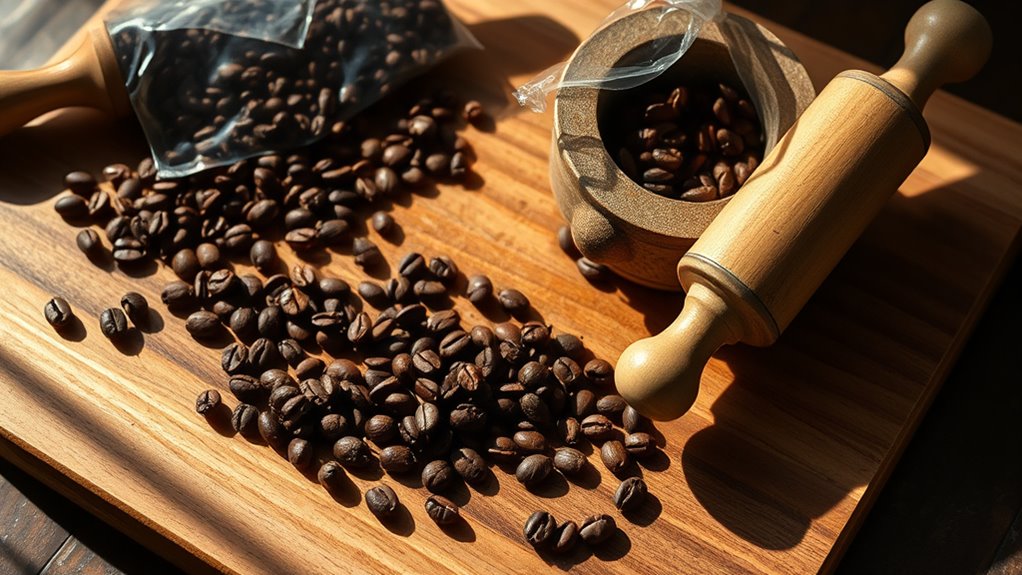
To get a consistent grind size, you should focus on monitoring the texture as you work.
If you’re using a blender or food processor, try short pulses and check the grind often to avoid over-processing.
This way, you’ll achieve the perfect size for your brewing method every time.
Use Short Pulses
How can you guarantee a consistent grind size when using a blender or food processor? The key is to use short pulses. Here are three tips to help you achieve that consistent texture:
- Pulse for 3-15 seconds: This prevents overheating and allows for a more uniform grind of your coffee beans.
- Pause between pulses: Frequent breaks help distribute the beans evenly, ensuring no chunk is left unground.
- Check and scrape: After each pulse, check the grind consistency and scrape down the sides of the container for even processing.
For best results, grind in small batches of 1/4 to 1/2 cup. This way, you’ll maintain control over the grind size and quality while enjoying your coffee!
Monitor Grind Texture
Achieving a consistent grind size is essential for maximizing the flavor of your coffee.
When using a mortar and pestle, crush coffee beans with a twisting motion, regularly checking the texture to prevent over-grinding.
If you opt for a blender or food processor, pulse in short bursts, pausing to scrape down the sides for even grinding while monitoring grind texture.
For the rolling pin method, start by breaking the beans into smaller pieces before rolling to achieve a uniform grind, checking frequently for your desired coarseness.
If using a hammer, tap gently on a zip-top bag, aiming for a coarse consistency perfect for cold brew or French press.
Always make sure your grind size matches your brewing method for ideal flavor extraction.
Brewing Methods for Coarsely Ground Coffee

When you choose coarsely ground coffee, you’ll find that it opens up a variety of brewing methods that enhance your coffee experience.
Here are three effective ways to brew with coarsely ground coffee:
- French Press: This method allows excellent extraction due to the larger surface area of the grounds. Simply steep for 4-5 minutes before pressing.
- Cold Brew: Combine coarsely ground coffee with cold water and steep for at least 10 hours to achieve a smooth, rich flavor.
- Makeshift Method: Pour boiling water over coarsely ground coffee in a heatproof container, steep, and then strain.
Using coarsely ground coffee can help prevent bitterness, making it perfect for these longer steeping methods.
Enjoy brewing coffee without grinding!
Seeking Help From Friends and Local Coffee Shops
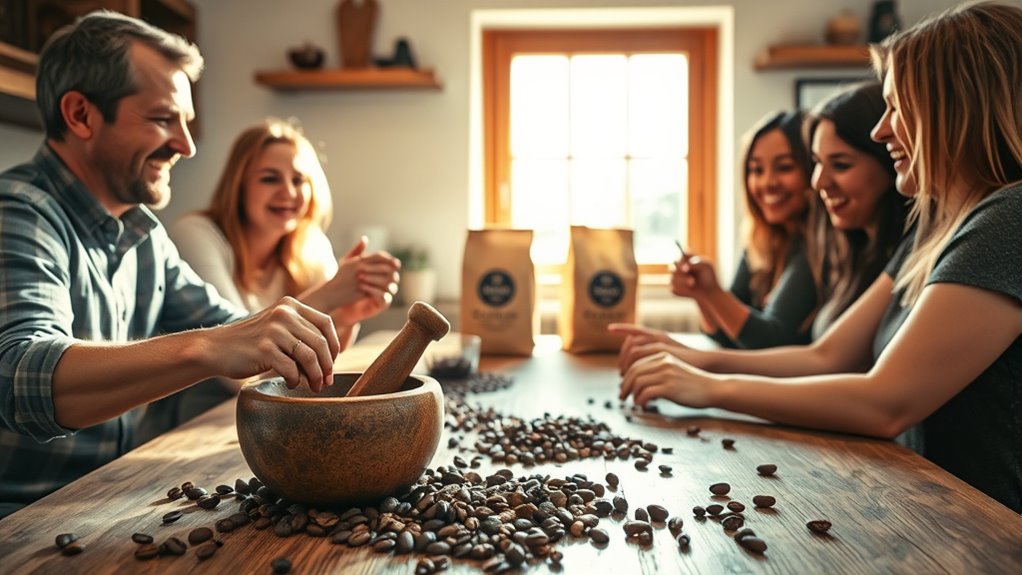
If you find yourself without a grinder, reaching out to friends or local coffee shops can be a smart solution.
You might be surprised to discover that a neighbor or coworker has a coffee grinder you can borrow, making it easy to enjoy freshly ground coffee.
Additionally, many local coffee shops offer grinding services for customers who purchase whole beans, so don’t hesitate to ask.
Engaging with baristas can also lead to opportunities, like getting your beans ground for free or in exchange for buying a drink.
It’s a great way to connect with your community while solving your coffee grinding dilemma.
Cost-Effective Solutions for Coffee Grinding Needs
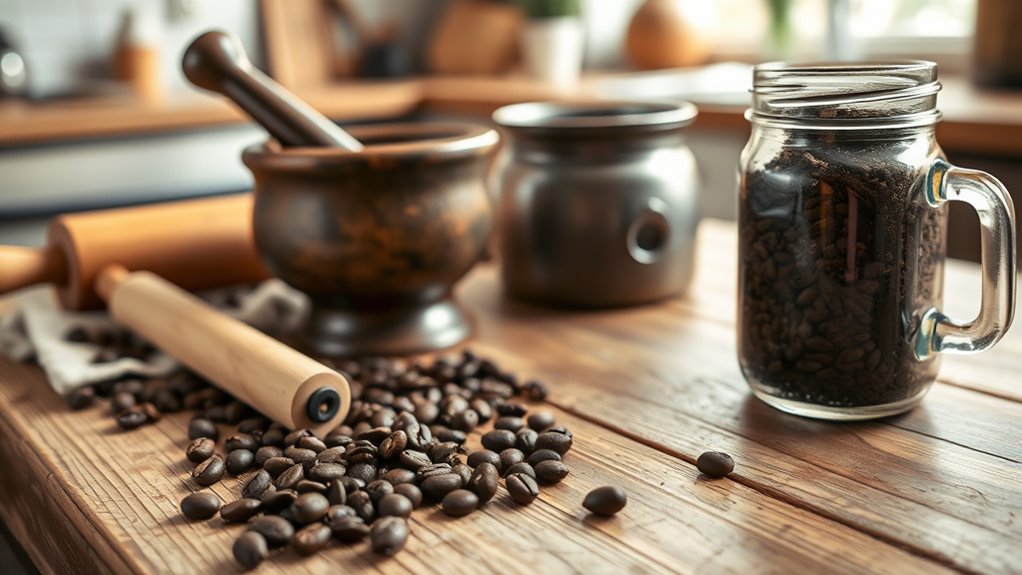
Finding cost-effective solutions for your coffee grinding needs can be easier than you think. You don’t need to break the bank to enjoy freshly ground coffee.
Here are three budget-friendly options:
- Manual Hand Grinders: Available at camping stores for around $20, they’re perfect for on-the-go coffee lovers. Butter can also be a great addition to your coffee for a creamy texture, and using low light office plants in your workspace can create a more enjoyable coffee grinding environment. Additionally, investing in quality coffee beans can significantly enhance the flavor of your brewed coffee. Grinding your own beans can preserve the freshness of coffee, ensuring you capture the full aroma and taste.
- Grocery Store Grinders: Many local grocery stores offer grinders for customer use, allowing you to grind beans you purchase without needing your own grinder.
- Inexpensive Electric Grinders: You can find electric grinders online for as low as $10, making it accessible for various budgets.
Investing in any of these solutions can greatly enhance your coffee experience while keeping your costs low! Additionally, it’s important to remember that budgeting for expenses can help ensure you allocate funds for your coffee needs without overspending.
Frequently Asked Questions
Is There a Way to Grind Coffee Without a Grinder?
Yes, you can definitely grind coffee without a grinder!
You might use a mortar and pestle for a controlled grind or a blender with short pulses to avoid overheating. A food processor is another great option, as it provides even grinding.
If you’re looking for a simpler method, try crushing the beans in a zip-top bag with a heavy object, like a rolling pin.
Each method will give you a different grind suitable for various brewing styles.
What if I Don’t Have a Coffee Grinder?
If you don’t have a coffee grinder, don’t fret—you’re not stuck in a caffeine-less wasteland!
You can use a blender for quick bursts, but be careful not to overheat those precious beans. A food processor works wonders too, letting you grind larger quantities evenly.
For a DIY approach, crush beans in a zip-top bag with a heavy object. Even a trusty mortar and pestle can do the trick, though it takes some time.
How to Grind Coffee With Hands?
To grind coffee with your hands, start by placing the beans in a sturdy zip-top bag.
Use a heavy object, like a cast iron pan or rolling pin, to crush the beans. For a coarser grind, gently tap and press down, avoiding excessive force.
If you want a finer grind, roll over the beans firmly.
Experiment with different techniques to find the grind size that works best for your brewing method.
Enjoy your coffee!
What Is the Best Way to Grind Coffee at Home?
Grinding coffee at home is like crafting a masterpiece; it requires the right tools and technique. You can use a mortar and pestle for precision, or a blender in quick bursts to avoid overheating.
If you’re in a pinch, place your beans in a zip-top bag and crush them with a heavy object for a coarse grind. Remember, consistency is key to revealing the full flavor potential in your brew.
Enjoy your coffee journey!
Conclusion
In the end, grinding coffee without a grinder might seem like an intimidating task, but with the right techniques, you can reveal the rich flavors of your beans. Think of it as a culinary adventure where every method is a new path leading to the perfect brew. Whether you’re using a blender or a mortar and pestle, remember that patience and practice make perfect. So roll up your sleeves and enjoy the journey to your ideal cup of coffee!
